Last updated on March 5th, 2022
Our site is reader supported, this means we may earn a small commission from Amazon and other affiliates when you buy through links on our site.
Conifers are plants that have stems and trunks covered in bark with woody stems. Many are fast-growing but you can also get some dwarf varieties that will grow just a few centimetres per year and make excellent container plants and low-growing groundcover plants.
There are plenty of small shrubs and vines that are included in the category of woody stems and conifers are one perfect example. Caring for conifers requires some of the same elements as caring for any other plants, such that they need adequate water (especially when young), the correct soil, which is usually slightly acidic and sunlight. There are a few other particular requirements for root treatment and pruning that you should be aware of.
Choosing your Conifers
When you think about choosing your conifers you need to pay attention to the structure and the root system of the options you are exploring. When selecting conifers from a nursery pay attention to the colour first and foremost. There should be a small description near the plants in question and those are indicative of healthy plants so if you are looking at a golden conifer but the description says it should be dark green, that particular conifer could be lacking nutrients. A common mistake many people make is choosing it for the colour, not realising that it will change colour through the seasons, often from lush green or golden yellow foliage to reddish-brown that may almost look like it’s dying. This is just something to bear in mind when choosing a conifer, especially if your main priority is its colour.
Take a look at the structure as well. Conifers shouldn’t have any awkward branching and they should be able to support themselves when standing upright. If you look at the roots and you see that the roots are starting to flare out from the trunk it could be indicative that the plant was buried too deeply. If you see that the roots are rootbound at the bottom you are going to need to tease them apart before you add them to your garden. This is not a reason for concern, but it is something you should be aware of.
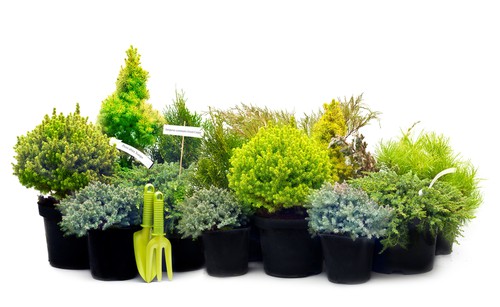
Conifers are grown in one of two ways, either directly in the field or in a container. Conifers grown in a container are more likely to be root bound and when you transplant them from the potting medium into your garden you want to loosen those roots up as much as possible. Conifers grown in the field are lifted from the ground, root pruned, wrapped in sacking and are often sold as root balled. This can bring with it some trauma involved with all of those preparatory steps and you may find that transplanting can exacerbate existing trauma and the conifer requires things like supplemental irrigation and care to give them the best start possible.
What to Consider Before Planting
It is recommended that you understand the native climate for your particular conifer. In its native habitat consider whether your conifer is exposed to a great deal of sun, minimum or maximum wind, heavy rain and heat so that you can try to replicate that habitat as much as possible. Not all conifers easily adapt to different conditions and some are a bit fussy. For example, conifers that have dark green foliage, blue foliage or silver foliage tend to perform best if they are given full sunlight.
Golden conifers usually do better if they receive morning sunlight and afternoon shade because they can burn in full sunlight. Conifers that have white variegation prefer deep shade and never direct sunlight. Certain species are meant to grow underneath large canopy trees and need a lot of space in the shade. Remember also that in addition to considering the placement of your conifer you need to consider how rapidly the selection you have will grow because some options will need a great deal more space in which to grow than others. Some conifers can grow 2-3ft a year such as a Leylandii while some slower growing dwarf varieties only grow 2-3cm a year.
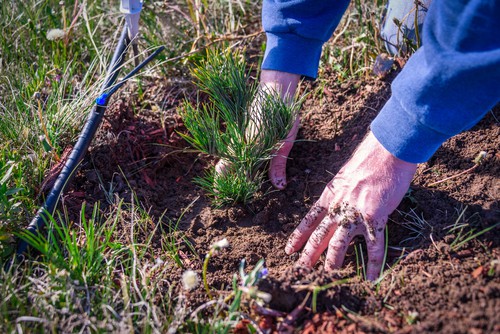
Planting a Conifer
When you are ready to plant your conifer you should dig a hole that is no more than the size of the root ball in depth and the width of the hole should be twice as wide as the root ball.
Add some soil improver or organic matter to the soil if the soil is poor. If the soil is good then adding a small handful of bonemeal will be enough to give it a good start and encourage it to root. Also, consider improving drainage by adding some grit to the soil if needed.
Prior to inserting the conifer into the hole, you want to remove any excess soil that is above the root flare and loosen the roots, particularly if it became root bound in a pot. Once you place the conifer inside the hole, backfill with soil until the root crown is barely visible and stake if needed.
Finally, water well and do not allow the soil to dry out.
General Care
When you first plant your conifer you want to water it thoroughly so that any air pockets are removed and the roots are able to access that water. Keep an eye on how moist the soil is for the first few months and remember that when first planted, they only have a small root system. Even if it has been raining, the conifers foliage can act like a canopy preventing the rainwater from reaching the plant’s rootball.
Usually, it’s a good idea to keep it well watered for the first few months and water daily at warmer times of the year if needed. After around 12 months, once they have established themselves, they can usually get all the water they need on their own.

Stake Conifers in Exposed Windy Areas
In some situations, you might need to use a stake if you have tall conifers or if they have been planted in a more exposed and windy position. These stakes can help keep the conifer upright, especially when it’s younger and still establishing its roots. Realistically trees need to be able to flex in order to develop trunk strength so you should only have the stakes in place for as much time as is necessary and until the root system holds the plant upright on its own.
Feeding
In reality, conifers very rarely require any type of feeding although it might benefit from feeding if you have one that looks a little unhealthy. When you first plant your conifer we recommend adding fertiliser into the soil to give your plant the best start. You don’t need to feed frequently because it can promote excessive top growth before the roots have had the opportunity to develop.
Mulching
When you first plant your conifer you want to mulch around the root ball. Mulching away from the trunk and around the root ball will help to keep the roots cool, especially during the summer and can help to keep them warm in the winter. Mulch also helps to improve moisture retention and prevent weed growth.
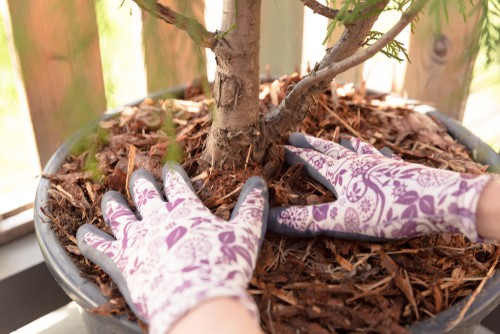
Pruning
Pruning a conifer is something that is rarely required, although you should definitely prune away any dead or diseased branches as soon as you see them. Beyond that, you may have to prune here or there to maintain the shape or prevent your tree from outgrowing its space. However, most conifers should not be pruned into old wood because they often do not recover and cannot produce new growth from old wood. A prime example of this is Leylandii, which is often pruned too hard and never recovers. Thuja plicata, on the other hand, is one type of conifer that does grow from old wood and is often a better choice when choosing a conifer for planting a hedge.
Trimming hedging conifers
It is important to only lightly trim conifers once or twice a year, only trimming off some of the current year’s foliage and avoiding cutting below the outlived foliage. You want to avoid pruning too hard as you will end up being left with a conifer that has brown dead patches that simply won’t recover.
Whorl Branched
These conifers branch once a year and at which point they produce new growth. If you are trying to prune this particular variety in order to maintain shape within a specific space in your garden, it is best to do it when it’s younger rather than when it has already outgrown the space. The tips that you see, which are the new growths are referred to as candles, and if you are going to trim you can cut down the candles (in half) in the middle of spring. If you want to keep your conifer the same size year after year you can remove the entire candle once it reaches 3 or 4cm.
Non-Whorl Branched
This variety produces new buds at the tips of branches and then randomly throughout the rest of the plant, which is why it’s commonly referred to as a random branched variety. You can prune this conifer a bit more frequently compared to the other category, however, you still need to look out for new growth versus old growth. You don’t want to prune into the old wood because this can damage the plants.
Propagation
Conifers are typically propagated naturally by way of seeds that fall out of their cones and you can propagate from cuttings as well. If you choose to do this, take a cutting is approximately 10cm from a healthy plant and grow them in your garden for at least one year prior to transplanting them into new pots or into a permanent position in your garden.
To complete this process you want to take your cuttings at the end of summer or the beginning of autumn, clipping several cuttings that are approximately 10cm long and removing the needles from the bottom third of the stem. Dip the cutting in rooting hormone and then place it inside a container made up of potting soil mixed with grit to allow for better drainage. You can read more about how to take conifer cuttings here.

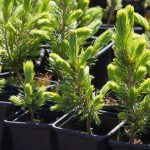
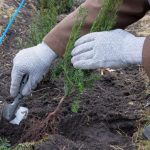
1 Comment
I planted five Juniper Skyrocket in concrete pot a year ago and only one survived. I need advice which conifer is best choice to plant to have green privacy screen. I plan to maintain the height of the plant about 170 cm. Thank you